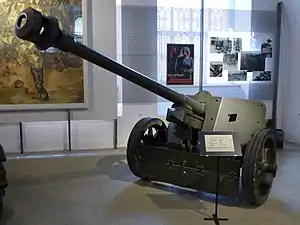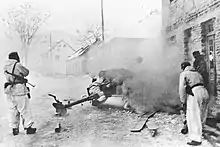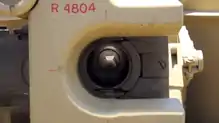7.5 cm Pak 40
The 7.5 cm Pak 40 (7,5 cm Panzerabwehrkanone 40 - lit. "7.5cm armour defence cannon 40") was a German 75 millimetre anti-tank gun developed in 1939–1941 by Rheinmetall and used during the Second World War. With 23,303 examples produced, the Pak 40 formed the backbone of German anti-tank guns for the later part of World War II, mostly in towed form, but also on a number of tank destroyers such as the Marder series.
| 7.5 cm Panzerabwehrkanone 40 | |
|---|---|
 A Pak 40 75 mm anti-tank gun, displayed in the Museum of Military History, Vienna. | |
| Type | Anti-tank gun |
| Place of origin | Nazi Germany |
| Service history | |
| In service | 1942–1945 |
| Used by | Nazi Germany Finland Kingdom of Hungary[1] Norway (postwar) |
| Wars | World War II Vietnam War |
| Production history | |
| Designer | Rheinmetall |
| Designed | 1939–1941 |
| Manufacturer | Rheinmetall |
| Unit cost | 12,000 RM |
| Produced | 1942–1945 |
| No. built | 23,303[2] |
| Specifications | |
| Mass | 1,425 kg (3,142 lb) in action[2] |
| Length | 6.2 m (20 ft 4 in) |
| Barrel length | 46 calibres: 3.45 m (11 ft 4 in) |
| Width | 2.08 m (6 ft 10 in)[3] |
| Height | 1.2 m (3 ft 11 in)[3] |
| Crew | 6[3] |
| Shell | Fixed QF 75×714mm R[3] |
| Caliber | 75 mm (2.95 inch) |
| Breech | semi-automatic horizontal sliding-block |
| Recoil | Hydro-pneumatic[3] |
| Carriage | Split trail |
| Elevation | −5° to +22° |
| Traverse | 65° |
| Rate of fire | 14 rounds per minute |
| Effective firing range | 1,800 m (1,969 yd) direct fire |
| Maximum firing range | 7,678 m (8,397 yd) indirect HE shell |
A modified version of the gun designed specifically for vehicle-mounting was the 7.5 cm KwK 40, which differed primarily in using more compact ammunition, thereby allowing more rounds to be carried inside the vehicles. The KwK 40 armed many of the German mid-war tank and destroyer designs, replacing the Pak 40 in the latter role.
Depending on the source, the Pak 40 may be referred to as the 7.5/L46, referring to the barrel's length in calibres. There were two versions of the KwK 40, which would be referred to as the 7.5/L43 or 7.5/L48.
Development
Development of the Pak 40 began after reports of new Soviet tank designs began to reach Berlin in 1939. The 5 cm Pak 38 was still in testing at this point, but it appeared it would not be powerful enough to deal with these newer designs. Contracts were placed with Krupp and Rheinmetall to develop what was essentially a 7.5 cm version of the Pak 38. However, while the Pak 38 made extensive use of light alloys to reduce overall gun weight, these were now earmarked for the Luftwaffe. As a result, the Pak 40 used steel throughout its construction and was proportionally heavier than the 5 cm model. To simplify production, the Pak 38's curved gun shield was replaced by one using three flat plates.[4] A version called the 7.5 cm FK 7M59 was proposed towards the end of the war to fill a dual-purpose role of field gun and anti-tank gun. The carriage was modified to provide +35° of elevation which increased maximum range to 13,300 m (14,500 yd).[5] Another dual purpose variant was the 7.5 cm FK 7M85 which used the gun and recoil system of the Pak 40 on the carriage of the 10 cm le FH 18/40.[5]
The project was initially given low priority, but following the invasion of the USSR in 1941 and the appearance of heavily armoured Soviet tanks such as the T-34 and KV-1, it was given an increased priority. The first pre-production guns were delivered in November 1941. In April 1942, the Wehrmacht had 44 guns in service; by 1943, the Pak 40 formed the bulk of German anti-tank artillery.
Operational use
The Pak 40 was the standard German anti-tank gun until the end of the war, and was supplied by Germany to its allies. Some captured guns were used by the Red Army.

23,303 Pak 40s were produced, and about 3,500 more were used to arm tank destroyers. The unit manufacturing cost amounted to 2,200 man-hours at 12,000 RM. A lighter automatic "weapon system" version incorporating a twelve-round magazine, the heaviest of the Bordkanone series of heavy calibre aircraft guns, was used as the BK 7,5 in the Henschel Hs 129B-3 and the Junkers Ju 88P-1 ground attack aircraft, and even intended as a production fitment for a possible He 177A-3/R5 heavy bomber adaptation late in 1942, originally prototyped in the field with BK 5 cannons, themselves adapted from the 5 cm KwK 39 tank gun from the Panzer III.
During the second half of World War II, some Romanian anti-tank platoons each had three Pak 40 guns. These were used interchangeably with Romania's own 75 mm Reșița Model 1943 anti-tank gun.[6]
Performance

The weapon was effective against almost every Allied tank until the end of the war, only struggling to penetrate heavier vehicles like the Russian IS tanks, the American M4A3E2 Sherman 'Jumbo' and M26 Pershing, and later variants of the British Churchill tank. The Pak 40 was much heavier than the Pak 38; its decreased mobility meant that it was difficult or even impossible to move without an artillery tractor on boggy ground.
The Pak 40 was first used in the USSR where it was needed to combat the newest Soviet tanks. It was designed to fire the same low-capacity APCBC, HE and HL projectiles that had been standardized for use in the long barrelled Kampfwagenkanone KwK 40 tank-mounted guns of the mid-war and later marks of the Panzer IV medium tank. In addition, there was an APCR shot (Panzergranate 40) for the Pak 40, a munition which - reliant on supplies of tungsten - eventually became very scarce.[7] According to the German Panzertruppen News Journal, 5,000 APCR rounds were expected in Dec. 1942 as replenishment for the Winter offensive.[8]
The main differences amongst the rounds fired by 75 mm German guns were in the length and shape of the cartridge cases as well as the primers used. The 7.5 cm KwK 40 (75x495mm) used in tanks had a fixed cartridge case twice the length of that used by the 7.5 cm KwK 37, the short barrelled 75 mm used on earlier tanks, and the 7.5 cm Pak 40 cartridge was a third longer than that used by the KwK 40. The Pak 40 used a percussion primer, while the vehicle mounted 75 mm guns used electrical primers. Other than minor differences with the projectiles' driving bands, all German 75 mm guns used the same 75mm projectiles.

The longer cartridge case of the Pak 40 allowed a larger charge to be used and a higher velocity for the PzGr 39 armour-piercing capped ballistic cap round to be achieved. The muzzle velocity was about 790 m/s (2,600 ft/s) as opposed to 740 m/s (2,400 ft/s) for the KwK 40 L/43 and 750 m/s (2,500 ft/s) for the L/48. The only 75mm fighting vehicle gun in general use by Germany that possessed a longer barrel than the Pak 40, the 7.5 cm KwK 42 on the Panther tank, could achieve a higher muzzle velocity of 935 m/s (3,070 ft/s) on what was essentially the same calibre and model of shell, with a differing propellant cartridge fixed to it for the KwK 42's use.
For unknown reasons, some 75 mm APCBC cartridges appear to have been produced with a charge that gave a muzzle velocity of about 770 m/s (2,500 ft/s). The first documented firing by the US of a Pak 40 recorded an average muzzle velocity of 776 m/s for its nine most instrumented firings.[9] Probably because of these results, period intelligence publications ("Handbook on German Military Forces") gave about 770 m/s as the Pak 40 APCBC muzzle velocity. Post war publications corrected this.[10]
German sources differ; the Official Firing Table document for the 75 mm KwK 40, StuK 40 and the Pak 40 dated October, 1943, gives 770 m/s on one of the APCBC tables.[11]
General characteristics



- Caliber: 75 mm
- Barrel length: L/46
- Rifling: 32 grooves, right-hand increasing twist, 1/24 to 1/18.
- Length with the carriage: 6.2 metres (20 ft 4 in)
- Length: 3.70 metres (12 ft 1.7 in)
- Width: 2.0 metres (6 ft 7 in)
- Height: 1.25 metres (4 ft 1 in)
- Weight (combat ready): 1,425 kilograms (3,142 lb)
- Traverse: 65°
- Elevation: -5° to + 22°
- Rate of fire: 14 rounds per minute
- Engagement range: 1,800 metres (5,906 ft)
- Indirect range: 7,678 metres (25,190 ft) (HE shell)
- Projectile weight: 3.18 to 6.8 kg (7 lb 0.2 oz to 14 lb 15.9 oz)
Ammunition
- Panzergranate 39 (PzGr. 39)
An armour-piercing, capped, ballistic cap (APCBC) projectile with explosive filler and tracer.
- Weight of projectile: 6.80 kg (15 lb 0 oz)
- Muzzle velocity: 790 m/s
- Panzergranate 40 (PzGr. 40)
An armour-piercing, composite rigid (APCR) projectile with a sub-calibre tungsten core.
- Weight of projectile: 4.05 kg (8 lb 15 oz)
- Muzzle velocity: 990 m/s
- Panzergranate 38 HL/B (PzGr. 38 HL/B)
A high-explosive anti-tank (HEAT) projectile with a shaped charge.
- Weight of projectile: 4.57 kg
- Muzzle velocity: 450 m/s
| Range | ||||
|---|---|---|---|---|
| Round | 100 m | 500 m | 1000 m | 1500 m |
| PzGr. 39 | 108 mm | 96 mm | 80 mm | 64 mm |
| PzGr. 40 | 143 mm | 120 mm | 97 mm | 77 mm |
| PzGr. 38 HL/B | 75 mm | 75 mm | 75 mm | 75 mm |
| Round | Muzzle velocity | Penetration |
|---|---|---|
| Armour-piercing | 792 m/s | 132 mm |
| APCR | 933 m/s | 154 mm |
| HE | 550 m/s | n/a |
Post-war use
After the war, the Pak 40 remained in service in several European armies, including Albania, Bulgaria, Czechoslovakia, Finland, Norway, Hungary and Romania. In 1955, USSR supplied 33 captured guns to Austria. They were kept in service into the 1960s.[13] North Vietnam also received some during the Vietnam War.[14]
Survivors
Pak 40s are or have been held in several military museums, outside museums or free entrance open-air fields:
See also
- 7.5 cm Pak 97/38 - captured French 75 mm anti-tank gun on German carriage
- 7.5 cm Pak 41 - 75 mm anti-tank gun based on squeeze bore principle
- 7.5 cm Pak 50 - A shortened L/30 version of Pak 40
- 7.5 cm KwK 40 - German tank gun version of Pak 40
- 7.5 cm FK 7M85 - A field gun based on the Pak40
Weapons of comparable role, performance and era
- 3 inch Gun M5 - similar US anti-tank gun
- 75 mm Reșița Model 1943 - Romanian anti-tank gun
References
- Notes
- Rada, Tibor (2001). A Magyar Királyi Honvéd Ludovika Akadémia és a Testvérintézetek Összefoglalt Története (1830-1945) (in Hungarian). II. Budapest: Gálos Nyomdász Kft. p. 1114. ISBN 963-85764-3-X.
- "7,5 cm Pak 40". Panzerworld. Retrieved 21 October 2014.
- Foss, Christopher (1977). Jane's Pocket Book of Towed Artillery. New York: Collier. p. 27. ISBN 0020806000. OCLC 911907988.
- Bishop, Chris (2002). The Encyclopedia of Weapons of World War II. Sterling Publishing. pp. 183–185.
- Hogg, Ian (1997). German artillery of World War Two. London: Greenhill Books. pp. 43–44. ISBN 1853672610. OCLC 36705743.
- Ronald L. Tarnstrom, Trogen Books, 1998, Balkan Battles, p. 407
- One document, "Terminal Ballistics" stipulates production of Panzergranate 40 ceased entirely in 1943.
- Nachrichtenblatt zur Panzerbeschusstafel 7,5 cm Pak 40 L/46 dated Nov. 1942
- "First Report of Test of a German 75 mm Pak 40 Antitank Gun and Seventeenth Report on Ordnance Program No. 5772
- Department of the Army Pamphlet No. 30-4-4, "Foreign Military Weapons and Equipment (U) Vol. 1 Artillery (U) dated August of 1955-this document was originally classified
- "Schusstafel für die 7,5cm Kampfwagenkanone 40"
- Nachrichtenblatt zur Panzerbeschusstafel 7,5 cm Pak 40 L/46 dated Nov. 1942
- "Rearming Austria: WWII weapons". wwiiafterwwii.wordpress.com. 14 June 2015.
- Grandolini, Albert (1998). Armor of the Vietnam War (2) Asian Forces. Armor at War 7017. Concord Publications. p. 17. ISBN 9789623616225.
- "Museot.fi - Hanko Front Line Museum". www.museot.fi.
- "Archived copy". Archived from the original on 3 November 2013. Retrieved 3 April 2012.CS1 maint: archived copy as title (link)
- "Damascus Military Museum (2): The Artillery". wordpress.com. 31 March 2012. Retrieved 12 April 2018.
- "75cm Pak 40".
- "75cm Pak 40".
- "75cm Pak 40 L60 (ORD 151)". Imperial War Museums.
- Bibliography
- Engelmann, Joachim and Scheibert, Horst. Deutsche Artillerie 1934-1945: Eine Dokumentation in Text, Skizzen und Bildern: Ausrüstung, Gliederung, Ausbildung, Führung, Einsatz. Limburg/Lahn, Germany: C. A. Starke, 1974
- Wolfgang Fleischer. Die 7,5-cm Panzerjägerkanone 40 // Waffen-Arsenal Sonderband S-54. — PODZUN-PALLAS-VERLAG, 1999. — 52 p. — ISBN 3-7909-0665-4.
- Werner Haupt. Panzerabwehrgeschütze 3,7-cm 5,0-cm 7,5-cm 8,8-cm-Pak 1934-1945 (ohne Selbstfahrlafetten) // Waffen-Arsenal Band 117, PODZUN-PALLAS-VERLAG. — 1989. — ISBN 3-7909-0360-4.
- Gander, Terry and Chamberlain, Peter. Weapons of the Third Reich: An Encyclopedic Survey of All Small Arms, Artillery and Special Weapons of the German Land Forces 1939-1945. New York: Doubleday, 1979 ISBN 0-385-15090-3
- Hogg, Ian V. German Artillery of World War Two. 2nd corrected edition. Mechanicsville, PA: Stackpole Books, 1997 ISBN 1-85367-480-X
- H.Dv. 481/77 Merkblatt fur die Munition der 7,5 cm Panzerjägerkanone 40 (7,5 cm Pak. 40), OKH Berlin 1942.
- D 393/1 7,5cm Panzerjägerkanone 40.- Heft 1: Beschreibung, Bedienung und Behandlung. — OKH / Heereswaffenamt, Berlin 1.Apr.1942.
- H.Dv. 119/324 – Schußtafel für die 7,5 cm Kampfwagenkanone 40 (7,5 cm Kw.K. 40), 7,5 cm Sturmkanone 40 (7,5 cm Stu.k. 40) und 7,5 cm Panzerjägerkanone 40 (7,5 cm Pak 40) mit Deckblättern 1-17, Oktober 1943.
External links
| Wikimedia Commons has media related to: |